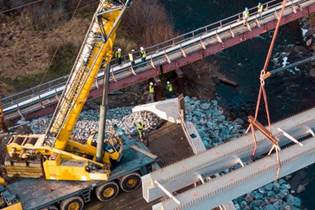With the infrastructure bill passed, the United States will see a decade of sustained investment and activity in infrastructure construction and rehabilitation. Composite materials are expected to play a significant role in this effort. Further, as the building and construction industry increasingly favors sustainable materials and designs, composites are expected to be specified for use in a variety of applications.
During this CW Tech Days event, sponsored by Composites One, experts will offer presentations to review and evaluate the composite materials, processes and applications that should and will be considered for use in the infrastructure and construction markets. During eight 30-minute Tech Day webinar sessions, materials and design engineering experts will assess topics including FRP rebar, bridge building, bridge repair, rail structures, marine structures and composites design for commercial construction.
Your $149 investment will provide valuable, high-utility information to help you understand how design engineering is evolving in composites manufacturing.
How the composites industry must evolve to enable wider adoption in Infrastructure and construction
Presented by Robert Walker
Past efforts to increase adoption have relied on convincing stakeholders to pay a higher upfront cost for secondary savings such as lower maintenance costs or a longer installation lifetime. This has resulted in incremental growth with faster adoption hampered by the fragmented and conservative nature of the infrastructure and construction market. However, at Future Materials Group we believe a more transformative approach to growing composites is now possible, shifting the focus from customized solutions to products.
Carbon fiber structural reinforcement in civil engineering: Largely untapped potential
Presented by Romain Coullette
Although carbon fibers have been used for decades to strengthen structures made with concrete, masonry, steel or cast iron, the construction industry worldwide is just starting to acknowledge the many benefits composite reinforcement has to offer. While countless worn constructions such as bridges will have to be retrofitted or repaired in the coming years, you will understand why innovative composite solutions are often the quickest, most effective and most economical solution to do the job. We’ll also share recent insights, examples and trends from Epsilon Composites’ 35 years of experience in pioneering the use of carbon fibers in infrastructures worldwide.
Sustainable materials for the future of transportation infrastructure
Presented by Ken Sweeney
The future of the infrastructure industry is dependent on how sustainable and resilient the planning, manufacturing, and construction of projects are. As we build and design infrastructure to be safe and last as long as possible, we need to take into consideration the life-cycle assessment (LCA) of our structures and the environmental product declarations of the materials we use to build them. Infrastructure should have low life cycle costs and have as little impact on the natural environment as possible. The use of fiber reinforced polymer (FRP) in infrastructure is a part of the solution to design and build sustainable projects that will stand the test of time.
FRP connections offer new ways to move people
Presented by Scott Reeve
Fiber-reinforced polymer (FRP) pedestrian bridges, rail platforms and cantilever sidewalks for vehicle bridges provide durable, creative modes of moving people that are becoming increasingly popular. With the U.S. population expected to reach 335 million in 2023, more Americans are using cars, trains, bicycles, motorcycles and their own two feet to reach their destinations. When it comes to the infrastructure needed to support this traffic, the focus typically spotlights roads and vehicle bridges. FRP’s design flexibility, light weight, corrosion resistance, aesthetics and fast installation continues to drive adoption of these alternate products by states, cities and transportation agencies across the nation. The public gains choices for both commuting and recreation that are safer and more attractive. Owners get long lasting, sustainable structures. And because FRP platforms, bridges and sidewalks are lightweight prefabricated structures, construction downtime—and its impact on the public—is minimal.
Innovative FRP solutions for repair of aging critical infrastructure
Presented by Mo Ehsani
Since its introduction in the late 1980s, FRP wet layup solutions have been successfully used worldwide to repair and strengthen buildings and bridges. This presentation focuses on some recent developments by the speaker that offer unique solutions for challenging infrastructure renewal applications. Among these are repair of submerged piles, seawalls and bulkheads, repair of pipelines including those for the oil and gas industries, and the construction of a record-breaking large diameter pipe near the jobsite that eliminated much of the transportation issues. Case studies from around the world where these sustainable solutions are used by the US military and other clients will be presented.
Key attributes and benefits of FRP composites for infrastructure and construction applications
Presented by Joe Fox
There is an extremely good fit between fiber-reinforced polymer (FRP) composites and the present and future infrastructure needs of our nation and the world. This presentation will illustrate the weight benefits, ease of installation, corrosion resistance, durability, resiliency to natural disasters, and lower life cycle costs of FRP composites in applications such as buildings, bridges, piers, seawalls and other categories of ASCE’s Infrastructure Report Card. Particular emphasis will be placed on how FRP composites can enable 1) decarbonization during construction and operation and 2) lightweight additions to existing structures.
Forward-thinking composites for infrastructure
Presented by Francesco Ierullo
Composites offer many solutions to our increasing infrastructure challenges. From extending the performance and capacity of power transmission lines to protecting against rising sea levels and helping ensure better 5G connectivity in our businesses and homes, the benefits of composites can be realized in various industries and applications. In this presentation Francesco Ierullo, Head of Sales Region Americas for Exel Composites, presents how composite conductor cores increase safety and capacity in power transmission, how corrosion resistant composites help protect our buildings against rising seas, how we can increase building energy efficiency with composite window and door frames, and finally how composites play a key role in keeping us connected with 5G.
Nonmetallic reinforcement in concrete construction – what engineers should know
Presented by Aparna Deshmukh
NEx envisions a future where everyone has the knowledge needed to use nonmetallic materials and products in the built environment effectively to meet the demands of an evolving world. One of the applications of nonmetallics in construction is the use of nonmetallic reinforcement. In September, ACI released a new code for GFRP-reinforced concrete structures referred to as ACI CODE 440.11-22. To supplement this code, NEx is developing a manual that will provide guidance for engineers to effectively design with GFRP rebars. NEx will share some of these experiences and expand on other upcoming NEx-funded manuals and specifications.















.jpg;maxWidth=300;quality=90)




